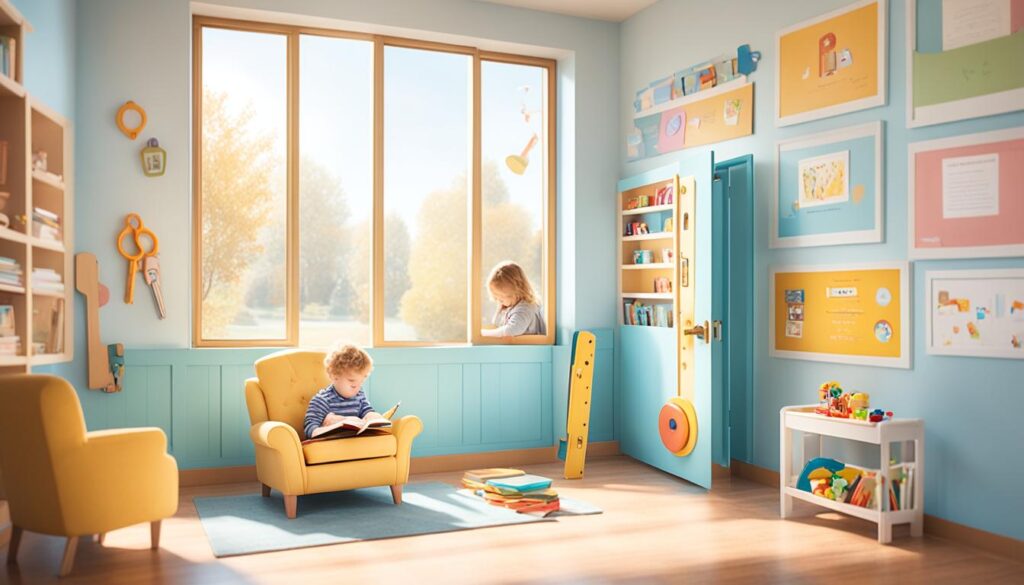Transforming Home Environments into Luxurious Learning Sanctuaries
Welcome to our article on empowering parents in education and transforming home environments into luxurious learning sanctuaries. As a parent, your involvement in your child’s education is crucial to their academic success. By creating a space that fosters a rich learning experience at home, you can actively engage in your child’s education and support their growth.
In this article, we will explore practical strategies and tips for transforming your home into a sanctuary of learning. From creating inviting spaces to designing calming environments, establishing daily learning routines, and utilizing technology, we will provide you with the tools you need to empower yourself as an educational partner for your child.
Key Takeaways:
- Creating inviting spaces at home encourages parent engagement in education.
- Designing a calming and productive environment is essential for parent empowerment.
- Establishing a daily learning routine fosters a strong family-school partnership.
- Utilizing technology can greatly enhance the learning experience for both parents and children.
- Cultivating a love for learning is crucial to long-term educational success.
Creating Inviting Spaces for Learning
When transforming your home into a learning sanctuary, it’s important to create inviting spaces that promote parent engagement in education. By designating specific areas in your home for reading, studying, and exploring new ideas, you can create an environment that encourages active participation in your child’s education. These spaces serve as a visual reminder of the importance of learning and provide opportunities for parents to actively engage in their child’s educational journey.
One of the key areas to consider is a comfortable and well-equipped study space. This space should be designed with your child’s needs in mind, offering a quiet and focused atmosphere where they can complete their schoolwork. By equipping this space with essential resources such as a desk, chair, and adequate lighting, you create an environment that supports their academic growth and success.
Additionally, a cozy reading nook can be a wonderful addition to your home learning environment. Fill it with a variety of books that cater to your child’s interests, fostering a love for reading and exploration. This dedicated space serves as an invitation for both parents and children to dive into captivating stories and have meaningful conversations. By encouraging regular reading sessions in this inviting nook, you are nurturing a lifelong passion for learning.
To visually summarize the concept of creating inviting spaces for learning, here is a table showcasing different areas in the home and their corresponding purposes:
| Area | Purpose |
|---|---|
| Study Space | Provide an environment for focused schoolwork |
| Reading Nook | Promote a love for reading and exploration |
By establishing these inviting spaces in your home, you are actively supporting parental involvement in education. They create opportunities for meaningful interactions, discussions, and engagement with your child’s learning journey. These spaces also serve as a tangible symbol of the family-school partnership, emphasizing the collaborative effort between parents and educators in supporting children’s academic growth.
Designing a Calming and Productive Environment
Designing a calming and productive environment is essential for empowering parents in education. When parents create a space that promotes focus and tranquility, they can actively engage in their child’s learning journey and contribute to their academic success. By incorporating soothing colors, providing storage solutions, and utilizing educational resources, parents can foster effective parent-teacher communication, engage parents in learning, and access valuable parental education resources.
Creating a Soothing Atmosphere
Use soothing colors, such as blues or greens, to create a sense of tranquility and focus.
Color plays a significant role in setting the mood and atmosphere of a learning environment. Utilize calming colors like blues or greens on the walls, furniture, or decor to create a serene ambiance. These colors have been shown to promote relaxation, concentration, and creativity, fostering an optimal environment for learning.
Providing Ample Storage and Organization
Provide ample storage and organization solutions to keep learning materials easily accessible.
A clutter-free space promotes focus and organization, making it imperative to have sufficient storage solutions for learning materials. Incorporate shelves, storage bins, or bookcases to keep books, supplies, and educational resources neatly organized. By having everything in its designated place, parents can easily access the necessary materials, empowering them to actively engage in their child’s learning.
Utilizing Educational Resources
Incorporate educational resources, such as educational games and online learning platforms, to engage parents in their child’s learning journey.
Education has evolved beyond traditional textbooks and classroom instruction. Make use of educational resources that align with your child’s interests and academic needs. Explore educational games, interactive apps, and online learning platforms that provide engaging and interactive learning experiences. These resources not only facilitate parent-child collaboration but also encourage independent exploration and reinforce concepts taught in school.
Fostering Effective Parent-Teacher Communication
Foster effective parent-teacher communication by setting up a designated area in your home for school notices, homework assignments, and important dates.
Open and effective communication between parents and teachers is vital for a child’s educational journey. Designate a central area in your home, such as a bulletin board or a whiteboard, to display school notices, homework assignments, and important dates. This dedicated space serves as a visual reminder and ensures that important information is readily accessible. Regularly check this area to stay informed about your child’s academic progress and maintain effective communication with their teachers.

Establishing a Daily Learning Routine
Establishing a daily learning routine is crucial for empowering parents in education. By setting aside dedicated time each day for academic activities, parents can actively engage in their child’s educational journey and promote a strong family-school partnership. Here are some strategies to help you establish an effective learning routine:
Create a Structured Schedule
Start by creating a structured schedule that includes specific times for academic activities. This schedule should include both independent learning and collaborative activities with your child. By having a clear plan, you can ensure that learning becomes a consistent and prioritized part of your daily routine.
Set Aside Time for Reading
Reading is an essential component of a child’s education. Dedicate a portion of your daily routine to reading, whether it’s reading together or encouraging independent reading. Choose books that align with your child’s interests and reading level to foster a love for reading.
Incorporate Math Practice
Math skills are fundamental to academic success. Include designated time for math practice in your daily routine. This can be through worksheets, online math games, or interactive activities that make learning math enjoyable for your child.
Engage in Educational Games
Make learning fun by incorporating educational games into your daily routine. These games can be board games, online games, or interactive apps that reinforce various subjects and skills. Playing together as a family not only strengthens your bond but also enhances your child’s learning experience.
Promote Reflection and Discussion
At the end of each learning session, take a few minutes to reflect and discuss what your child has learned. Encourage them to share their thoughts, ask questions, and express their opinions. By engaging in meaningful discussions, you can deepen their understanding of the topics and promote critical thinking skills.
“Establishing a daily learning routine is a powerful way for parents to actively engage in their child’s education and foster a strong partnership with the school. By making learning a consistent part of their daily lives, parents can help their children thrive academically and develop a lifelong love for learning.”
By establishing a daily learning routine, parents can create a structured and supportive environment that encourages their child’s educational growth. This routine not only benefits their academic progress but also strengthens the bond between parents and their children. With consistent involvement and active participation in their child’s learning journey, parents can make a significant impact on their educational success.
Utilizing Technology for Learning
In today’s digital age, technology has become an invaluable tool for supporting student learning at home and enhancing parent-teacher communication. By harnessing the power of educational apps, websites, and online resources, parents can actively engage in their child’s education and foster a strong partnership with their child’s teachers.
Here are some practical tips for utilizing technology to empower parents in education:
- Explore educational apps and websites: Take advantage of the wide range of educational apps and websites available to support your child’s learning. Whether it’s interactive math games, language learning platforms, or science simulations, these digital resources can provide additional practice and help reinforce key concepts.
- Facilitate communication with teachers: Use technology to stay connected with your child’s teachers. Many schools provide online platforms or communication tools where parents can easily communicate with teachers, receive updates on assignments and projects, and discuss their child’s progress. Regular communication with teachers can help you stay informed about your child’s academic needs and progress.
- Encourage online exploration: Support your child in exploring online educational content that aligns with their interests and academic goals. Encourage them to engage in virtual learning experiences, such as virtual field trips, educational videos, and online tutorials. This can enhance their understanding of various subjects and spark their curiosity.

Your child’s education is no longer confined to the classroom. Embracing technology allows parents to actively participate in their child’s learning journey and provide additional support at home. By incorporating educational apps, facilitating communication with teachers, and encouraging online exploration, parents can leverage technology to enrich their child’s educational experience.
Cultivating a Love for Learning
When transforming your home into a luxurious learning sanctuary, one of the key goals is to cultivate a love for learning in your child. By creating a positive and encouraging environment, parents can instill a passion for education that will last a lifetime.
One important aspect of cultivating a love for learning is creating an atmosphere where mistakes are seen as opportunities for growth. Encourage your child to take risks and embrace the learning process, even when faced with challenges. By fostering a growth mindset, you are teaching them that making mistakes is a natural part of the learning journey.
“The sooner you make your first five thousand mistakes, the sooner you will be able to correct them.” – Kimon Nicolaides
Celebrating achievements and milestones is another effective strategy for nurturing a love for learning. Recognize and praise your child’s efforts, whether it’s completing a challenging assignment or mastering a new skill. This positive reinforcement fosters a sense of pride and motivation, encouraging them to continue their educational journey with enthusiasm.
Engaging in educational activities that align with your child’s interests and passions is also crucial for cultivating a love for learning. Encourage them to explore topics and subjects they are curious about. Plan educational outings, such as visits to museums, science centers, or historical sites, to spark their curiosity and provide real-world context for their learning.
Fostering a Lifelong Love for Learning
Cultivating a love for learning sets the foundation for a lifelong commitment to education. By empowering your child to become an active participant in their own learning, you are equipping them with essential skills and habits that will benefit them academically and personally.
Through parental engagement strategies and a strong family-school partnership, parents can create an environment that supports and nourishes their child’s educational journey. By transforming your home into a luxurious learning sanctuary and adopting these practices, you are providing your child with the tools and motivation to thrive academically and beyond.
| Benefits of Cultivating a Love for Learning |
|---|
| 1. Increased motivation and engagement in school |
| 2. Improved academic performance and problem-solving skills |
| 3. Enhanced critical thinking and creativity |
| 4. Development of lifelong learning habits |
| 5. Increased self-confidence and love for personal growth |
Incorporating Real-World Experiences
Incorporating real-world experiences into the learning environment is a powerful way to foster parent empowerment and promote school-home collaboration. By taking advantage of local resources such as museums, zoos, and community events, parents can provide their children with hands-on learning opportunities that go beyond the traditional classroom.
Encouraging your child to participate in extracurricular activities and join clubs or organizations that align with their interests is another effective way to incorporate real-world experiences. These activities allow children to apply their knowledge and skills in practical settings and develop important life skills such as teamwork, leadership, and problem-solving.
“Engaging children in real-world experiences not only enhances their learning but also strengthens the bond between school and home. It creates a collaborative environment where parents, teachers, and students work together to expand educational horizons.”
By bridging the gap between school and home through real-world experiences, parents can actively collaborate with teachers and empower their children to apply their knowledge in meaningful ways. This collaboration fosters a deeper understanding of academic concepts and encourages children to see the relevance of their learning in the real world.
Hands-On Learning Opportunities
One way to incorporate real-world experiences is to visit local museums, zoos, and other educational centers. These outings provide hands-on learning opportunities and allow children to explore various subjects in a stimulating environment.
For example, a trip to a science museum can spark curiosity about scientific concepts and encourage children to conduct their own experiments at home. A visit to a historical site can inspire discussions about different time periods and cultures, prompting children to delve deeper into their studies.
Extracurricular Activities and Clubs
Encouraging children to participate in extracurricular activities and join clubs or organizations is another effective way to incorporate real-world experiences. It allows children to apply their knowledge and skills in a practical context while developing additional interests and talents.
Whether it’s joining a robotics club, participating in community service projects, or taking up a musical instrument, these activities offer opportunities for children to engage with real-world challenges and develop important life skills beyond academic knowledge.
Quotes from Experts
“Incorporating real-world experiences into education is a powerful way to foster parent empowerment and promote collaboration between the school and home. It creates a shared understanding and creates a stronger foundation for student success.” – Dr. Jane Richards, Education Consultant
Through incorporating real-world experiences, parents play a crucial role in fostering their child’s empowerment and development. By actively engaging in school-home collaboration, parents can expand their child’s educational horizons and inspire a lifelong love for learning.
Prioritizing Open and Effective Communication
Prioritizing open and effective communication is crucial to fostering effective parent-teacher communication, parent involvement in schools, and parental engagement strategies. By establishing clear channels of communication with your child’s teachers, you can stay informed about their progress, assignments, and any areas that may require additional support. Actively participating in parent organizations and educational committees allows you to contribute to school-wide initiatives and advocate for the needs of your child and other students.
Here are some practical tips for prioritizing open and effective communication:
- Establish regular communication channels with your child’s teachers. This can be done through email, phone calls, or attending parent-teacher conferences.
- Stay informed about your child’s progress and academic performance by regularly checking their assignments, grades, and feedback.
- Actively participate in parent-teacher associations or other parent organizations to stay connected with the school community.
- Collaborate with teachers to develop an individualized learning plan for your child, focusing on their strengths, weaknesses, and areas for improvement.
- Attend school events and meetings to engage with teachers, administrators, and other parents.
Example of Effective Parent-Teacher Communication
“My son’s teacher, Mrs. Johnson, has been incredibly responsive and supportive. Whenever I have a question or concern, she always responds promptly and provides detailed insights into my son’s progress. Through open and ongoing communication, we have been able to work together to address any challenges he may be facing and develop strategies for his success. Mrs. Johnson’s dedication to effective communication has truly made a positive impact on our parent-teacher partnership.”
– Parent testimonial
By prioritizing open and effective communication, parents can establish a strong partnership with teachers, actively contribute to their child’s education, and promote a collaborative and supportive learning environment.

| Benefits of Open Communication | Strategies for Effective Communication |
|---|---|
|
|
Building a Supportive Learning Network
Building a supportive learning network is vital for engaging parents in learning and empowering them in education. By connecting with other parents in your community, you can share valuable resources, tips, and experiences that contribute to your child’s academic success.
Joining parent support groups or online communities opens up opportunities to exchange ideas, discuss challenges, and discover best practices for parent involvement in schools. These platforms create a space where parents can find support and connect with like-minded individuals who share a common goal of supporting their child’s education.
To further enhance your knowledge and skills as an educational partner, seek out parental education resources like workshops, webinars, or online courses. These educational programs provide parents with valuable insights, strategies, and practical techniques to actively engage in their child’s learning journey.
Benefits of Building a Supportive Learning Network:
- Access to a wealth of knowledge and expertise from experienced parents and education professionals.
- Validation and emotional support from a community of parents who understand the joys and challenges of raising a child in an educational setting.
- Exposure to diverse perspectives and innovative ideas that can inspire and enhance your approach to parent involvement in schools.
- Opportunities for collaboration and joint initiatives that contribute to a positive impact on your child’s educational experience.
By building a supportive learning network, parents can collaborate, learn from one another, and strengthen their engagement in their child’s education. Together, we can create a nurturing and empowering environment that fosters optimal learning outcomes.

Providing Access to Educational Resources
Supporting student learning at home and promoting parental involvement in children’s education are crucial aspects of empowering parents in education. One effective way to achieve this is by providing access to a wide range of educational resources.
Creating a home library is a wonderful start to foster a love for reading and learning. Fill it with a diverse collection of books that cater to your child’s interests and reading level. From captivating stories to informative non-fiction, a well-stocked home library can be a gateway to new knowledge and imagination.
Additionally, explore online educational platforms and websites that offer interactive learning materials. These resources provide engaging activities, videos, and games that align with your child’s curriculum and learning goals. Online educational platforms also offer the convenience of accessing educational content from anywhere, anytime.
Subscribing to educational magazines or newsletters allows you to receive timely resources and activity ideas. These publications often provide insights into the latest trends and research in education, as well as suggestions for fun learning activities that you can engage in with your child.
Benefits of Providing Access to Educational Resources
By providing access to a wide range of educational resources, parents play an active role in supporting their child’s learning and broadening their academic horizons. The benefits of providing access to these resources include:
- Enhancing academic skills and knowledge
- Fostering a love for learning and curiosity
- Encouraging independent exploration and self-directed learning
- Developing critical thinking and problem-solving skills
- Expanding cultural awareness and understanding
“Education is the most powerful weapon which you can use to change the world.” – Nelson Mandela
Access to educational resources empowers parents to actively engage in their child’s education journey and provides opportunities for shared learning experiences. It strengthens the parent-child bond and creates a supportive environment for academic growth.
When parents have access to a wide range of educational resources, they can tailor their child’s learning experience to their unique interests, strengths, and goals. Whether it’s reading books together, exploring online platforms, or participating in educational activities, parents can play a vital role in their child’s educational development.
By providing access to educational resources, parents can actively support their child’s learning, nurture a love for lifelong learning, and establish a strong foundation for educational success.
Encouraging Active Learning and Exploration
Encouraging active learning and exploration is key to empowering parents in education. By engaging in hands-on activities that promote critical thinking, problem-solving, and creativity, parents can actively involve themselves in their child’s educational journey. Encouraging a curiosity-driven mindset by fostering questioning and inquiry-based learning can further enhance a child’s learning experience.
Partnering with your child’s teachers can take active learning and exploration to the next level. Collaborating with educators to design projects and assignments that allow for student-led exploration enables children to take ownership of their education. This approach nurtures essential lifelong skills and a deeper understanding of the subject matter.
Incorporating active learning and exploration into the educational journey strengthens family involvement in education, promotes effective parent-teacher communication, and fosters parent empowerment.
Fostering Critical Thinking and Problem-Solving
Active learning and exploration play a significant role in fostering critical thinking and problem-solving skills in children. By engaging in hands-on activities, children are encouraged to analyze information, apply logical reasoning, and develop creative solutions. This process prepares them for real-world challenges and nurtures their ability to think independently.
Whether it’s solving puzzles, conducting experiments, or engaging in role-playing activities, parents can actively participate in these experiences and encourage their child’s problem-solving abilities. Emphasizing the importance of critical thinking in everyday life helps children become adaptable and resourceful problem solvers.
Developing Creativity and Imagination
Active learning and exploration also contribute to the development of creativity and imagination. By providing opportunities for children to express their ideas and think outside the box, parents ignite their creative potential. Engaging in arts and crafts, storytelling, or imaginative play nurtures their ability to generate unique solutions and explore new possibilities.
Parents can create a conducive environment for developing creativity by providing open-ended materials, such as art supplies, building blocks, or nature-inspired objects. Emphasizing the value of imagination in various aspects of life nurtures children’s ability to approach challenges from different perspectives and discover innovative solutions.
Empowering Lifelong Learning
Active learning and exploration empower children to become lifelong learners. By encouraging them to ask questions and explore their natural curiosity, parents foster a love for learning that extends beyond the classroom. This mindset lays the foundation for a lifetime of intellectual growth and personal development.
Incorporating active learning and exploration into a child’s educational journey strengthens family involvement in education by creating opportunities for parents to actively support and engage with their child’s learning process. By fostering effective parent-teacher communication, parents can better understand their child’s educational needs and provide appropriate support at home.
Fostering parent empowerment is another significant outcome of active learning and exploration. When parents actively participate in their child’s education, they feel more confident in their ability to contribute to their child’s success and advocate for their educational needs.
“Active learning and exploration not only enhance educational experiences but also foster critical thinking, problem-solving, creativity, and curiosity. By actively engaging in their child’s educational journey and collaborating with teachers, parents empower their child to take ownership of their education and develop lifelong skills.”
| Benefits of Encouraging Active Learning and Exploration | How to Incorporate Active Learning and Exploration |
|---|---|
|
|
Conclusion
Empowering parents in education is crucial for supporting children’s academic growth and creating a rich learning experience at home. By providing parents with the right strategies and resources, we can enable them to actively engage in their child’s education and become confident educational partners.
One way to empower parents is by creating inviting spaces in the home that foster learning. Designating specific areas for reading, studying, and exploring new ideas encourages parental involvement in education and strengthens the family-school partnership.
In addition, establishing a daily learning routine, utilizing technology for educational purposes, prioritizing open communication with teachers, and building a supportive learning network are all essential components of empowering parents in education.
By transforming home environments into luxurious learning sanctuaries, parents can provide their children with nurturing and empowering spaces for educational success. With parental empowerment programs and a commitment to supporting parents in education, we can create a strong foundation for children’s future academic achievements.
FAQ
How can I create inviting spaces for learning in my home?
What can I do to design a calming and productive environment in my home?
How can I establish a daily learning routine for my child?
How can I utilize technology to support my child’s learning at home?
What can I do to cultivate a love for learning in my child?
How can I incorporate real-world experiences into my child’s learning?
What is the importance of open and effective communication with my child’s teachers?
How can I build a supportive learning network as a parent?
What can I do to provide access to educational resources at home?
How can I encourage active learning and exploration in my child?
Source Links
- https://kasiakarskadesign.com/transform-your-home-into-a-sanctuary-7-tips-included/
- https://thetraveldivas.com/elevate-your-self-care-transform-your-home-into-a-wellness-sanctuary/
- https://medium.com/modern-women/from-chaos-to-calm-transforming-my-post-pandemic-living-space-into-a-sanctuary-1758aba14d2f
